The diagram shows set up for the laboratory preparation of a pungent alkaline gas.1. Name the gas collected in the jar.2. Write the balanced equation for the above preparation3. State how the gas is collected?4. Name the drying agent used.5. State how you will find out that the jar is full of pungent gas?
1. Ammonia NH3 2. NH4Cl + Ca OH2 → CaCl2 + 2H2O + 2NH3 ↑3. Downward displacement of air4. Quicklime CaO5. Bring a rod dipped in HCl near it. Dense white fumes of ammonium chloride will be formed.
Related Solutions
The diagram shows an experimental set up for the laboratory preparation of a pungent smelling gas. The gas is alkaline in nature.
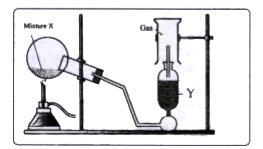
Name the gas collected in the jar.
View SolutionThe diagram shows an experimental set up for the laboratory preparation of a pungent smelling gas. The gas is alkaline in nature. Name the gas collected in the jar.
View SolutionThe diagram shows an experimental set up for the laboratory preparation of a pungent smelling gas. The gas is alkaline in nature.
Name the gas collected in the jar.
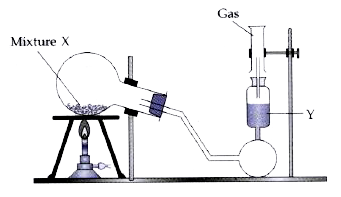
View SolutionThe diagram shows an experimental set up for the laboratory preparation of a pungent smelling gas. The gas is alkaline in nature.
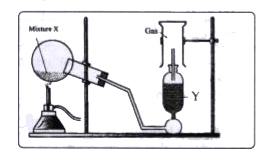
How will you find that the jar is full of gas?
View SolutionThe diagram shows an experimental set up for the laboratory preparation of a pungent smelling gas. The gas is alkaline in nature. How will you find that the jar is full of gas?
View SolutionThe diagram shows an experimental set up for the laboratory preparation of a pungent smelling gas. The gas is alkaline in nature.
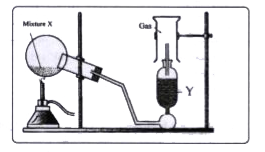
Name the drying agent used.
View SolutionThe diagram shows an experimental set up for the laboratory preparation of a pungent smelling gas. The gas is alkaline in nature. How is the gas being collected ?
View SolutionThe diagram shows an experimental set up for the laboratory preparation of a pungent smelling gas. The gas is alkaline in nature.
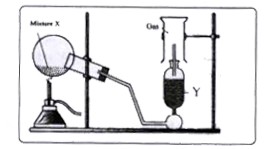
Write the balanced equation for the above preparation.
View SolutionThe nitrogen which is produced /prepared in the laboratory is collected in gas jar by
View Solutionഗ്യാസ്ജാറിലെ വായുവിനെ മുകളിലേക്ക് ആദേശം ചെയ്താണ് ക്ലോറിന് ശേഖരിക്കുന്നത്ല.ഭിച്ച ക്ലോറിന്വാതകത്തെ ജലത്തിലൂടെ കടത്തിവിടുന്നതെന്തിനാണ്?
View SolutionThe gas jar for collecting ammonia is kept inverted. Why?
View SolutionThe diagram shows the apparatus set-up for an experiment. Gas jar ( A) contains a brown gas, nitrogren dioxide and gas jar ( B) contains hydrogen > The molecular masses of nitrogen dioxide and hydrogen are 46 and 2 respectively.

Describe and explain the follwoing observations in the two gas jars as the experiment proceeds.
The amount of the gases in the gas jars.
View SolutionThe gas jar used for collecting ammonia is kept inverted .Why?
View SolutionThe diagram shows an apparatus for the laboratory preparation of hydrogen chloride.
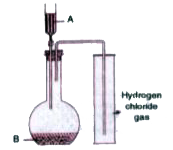
How would you check whether or not the gas jar is filled with hydrogen chloride ?
View SolutionThe following questions are pertaining to the laboratory preparation of hydrogen chloride gas:
How would you check whether or not the gas jar is filled with hydrogen chloride?
View SolutionName:
A greenish yellow gas with pungent smell.
View SolutionThe diagram shows the apparatus set-up for an experiment. Gas jar ( A) contains a brown gas, nitrogren dioxide and gas jar ( B) contains hydrogen > The molecular masses of nitrogen dioxide and hydrogen are 46 and 2 respectively.

Describe and explain the follwoing observations in the two gas jars as the experiment proceeds.
The speed of the gas particles.
View SolutionThe diagram shows the apparatus set-up for an experiment. Gas jar ( A) contains a brown gas, nitrogren dioxide and gas jar ( B) contains hydrogen > The molecular masses of nitrogen dioxide and hydrogen are 46 and 2 respectively.

Describe and explain the follwoing observations in the two gas jars as the experiment proceeds.
The colour of the gas.
View Solution(i) Write the equation for the laboratory preparation of hydrogen. (ii) How is the gas collected? (iii) Write the confirmatory test for Hydrogen.
View SolutionState the method used with reasons for drying and collecting ammonia gas.
View Solution